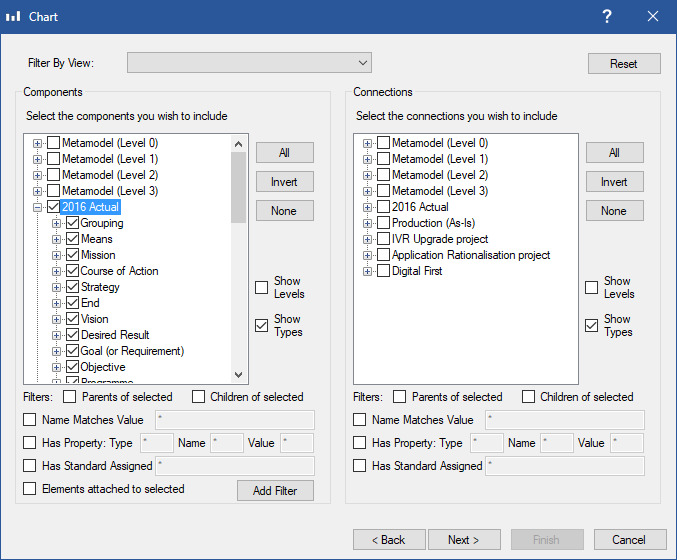|
When creating a diagram, 3D view, report, standard chart or running a simulation, the standard element selection window is used to select elements you want to analyse/view.

Standard Element Selection Window
Pulldowns
•Filter by View will include the elements from a previously saved view (i.e. Diagram, Chart, 3D). In this way you can perform complex 'join' queries by treating another view as a saved 'query'.
Checkboxes
•Show Levels will group the element according to the level by which they occur in the tree. Level 1 is the top most level.
•Show Types will group the elements according to the types that they are.
•Parents of selected will include the parent elements of any selected elements. In this way you can ensure that only the hierarchy above any children will be included for a "bottom-up" selection.
•Children of selected will include the children elements of any selected elements. In this way you can ensure that only the hierarchy below any parents will be included for a "top-down" selection.
•Name Matches Value will include only those elements that have a Name containing the specified text(Please note: Wildcards (i.e. ? and *) can be used). In this way you can form a "semantic" query.
•Has Property Type/Name/Value will include only those elements that have a Property Type, Name and Value containing the specified text either directly on the element or on its Standards (Please note: Wildcards (i.e. ? and *) can be used. E.g. ?* in the Value field will give all elements that have a non-blank Value for the given Property). In this way you can form a "semantic" query.
•Has Standard will include only those elements that have an Standard name containing the specified text(Please note: Wildcards (i.e. ? and *) can be used. E.g. HP* will give all elements with at least one Standard starting with the letters H and P). In this way you can form a "semantic" query.
•Components/Connections attached to selected will include any attached elements to those that have been selected. In this way a "call-tree" or "impact-analysis" can be selected.
 Note Note
If you have both Show Levels and Show Types selected then you can choose to have the tree show levels first or types first by the button that will appear above the two checkboxes.
 Tip Tip
Once an item is selected in the Standard Element Selection Window, it will not be subject to any further filter changes until it is deselected. Since there is no native way to search for two different sets of elements at once (e.g. Components with Standard A OR Standard B), you can search first for one set, select the desired components, and then perform a second search for the second set.
 Tip Tip
The various text fields to filter the components/connections are Case insensitive so casing does not need to be adhered to when filtering.
Buttons
•Reset sets all the filters to default as unfiltered.
•All selects all the elements.
•Invert deselects all the currently selected elements and selects all those that weren't selected.
•None deselects all the elements.
•Add Filter selects the resulting content of the current filter settings and allows selection of additional content as effectively an AND or JOIN filter.

See Also
Analysing your architecture

© 2001-2024 Avolution Pty Ltd, related entities and/or licensors. All rights reserved.
|